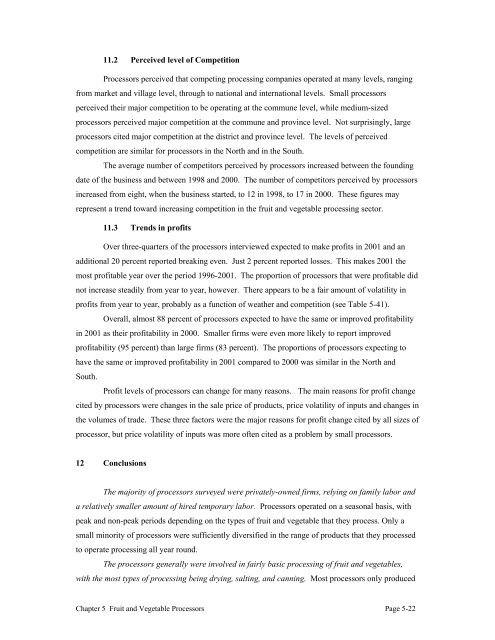Fruits and Vegetables in Vietnam - International Food Policy ...
Fruits and Vegetables in Vietnam - International Food Policy ...
Fruits and Vegetables in Vietnam - International Food Policy ...
You also want an ePaper? Increase the reach of your titles
YUMPU automatically turns print PDFs into web optimized ePapers that Google loves.
11.2 Perceived level of Competition<br />
Processors perceived that compet<strong>in</strong>g process<strong>in</strong>g companies operated at many levels, rang<strong>in</strong>g<br />
from market <strong>and</strong> village level, through to national <strong>and</strong> <strong>in</strong>ternational levels. Small processors<br />
perceived their major competition to be operat<strong>in</strong>g at the commune level, while medium-sized<br />
processors perceived major competition at the commune <strong>and</strong> prov<strong>in</strong>ce level. Not surpris<strong>in</strong>gly, large<br />
processors cited major competition at the district <strong>and</strong> prov<strong>in</strong>ce level. The levels of perceived<br />
competition are similar for processors <strong>in</strong> the North <strong>and</strong> <strong>in</strong> the South.<br />
The average number of competitors perceived by processors <strong>in</strong>creased between the found<strong>in</strong>g<br />
date of the bus<strong>in</strong>ess <strong>and</strong> between 1998 <strong>and</strong> 2000. The number of competitors perceived by processors<br />
<strong>in</strong>creased from eight, when the bus<strong>in</strong>ess started, to 12 <strong>in</strong> 1998, to 17 <strong>in</strong> 2000. These figures may<br />
represent a trend toward <strong>in</strong>creas<strong>in</strong>g competition <strong>in</strong> the fruit <strong>and</strong> vegetable process<strong>in</strong>g sector.<br />
11.3 Trends <strong>in</strong> profits<br />
Over three-quarters of the processors <strong>in</strong>terviewed expected to make profits <strong>in</strong> 2001 <strong>and</strong> an<br />
additional 20 percent reported break<strong>in</strong>g even. Just 2 percent reported losses. This makes 2001 the<br />
most profitable year over the period 1996-2001. The proportion of processors that were profitable did<br />
not <strong>in</strong>crease steadily from year to year, however. There appears to be a fair amount of volatility <strong>in</strong><br />
profits from year to year, probably as a function of weather <strong>and</strong> competition (see Table 5-41).<br />
Overall, almost 88 percent of processors expected to have the same or improved profitability<br />
<strong>in</strong> 2001 as their profitability <strong>in</strong> 2000. Smaller firms were even more likely to report improved<br />
profitability (95 percent) than large firms (83 percent). The proportions of processors expect<strong>in</strong>g to<br />
have the same or improved profitability <strong>in</strong> 2001 compared to 2000 was similar <strong>in</strong> the North <strong>and</strong><br />
South.<br />
Profit levels of processors can change for many reasons. The ma<strong>in</strong> reasons for profit change<br />
cited by processors were changes <strong>in</strong> the sale price of products, price volatility of <strong>in</strong>puts <strong>and</strong> changes <strong>in</strong><br />
the volumes of trade. These three factors were the major reasons for profit change cited by all sizes of<br />
processor, but price volatility of <strong>in</strong>puts was more often cited as a problem by small processors.<br />
12 Conclusions<br />
The majority of processors surveyed were privately-owned firms, rely<strong>in</strong>g on family labor <strong>and</strong><br />
a relatively smaller amount of hired temporary labor. Processors operated on a seasonal basis, with<br />
peak <strong>and</strong> non-peak periods depend<strong>in</strong>g on the types of fruit <strong>and</strong> vegetable that they process. Only a<br />
small m<strong>in</strong>ority of processors were sufficiently diversified <strong>in</strong> the range of products that they processed<br />
to operate process<strong>in</strong>g all year round.<br />
The processors generally were <strong>in</strong>volved <strong>in</strong> fairly basic process<strong>in</strong>g of fruit <strong>and</strong> vegetables,<br />
with the most types of process<strong>in</strong>g be<strong>in</strong>g dry<strong>in</strong>g, salt<strong>in</strong>g, <strong>and</strong> cann<strong>in</strong>g. Most processors only produced<br />
Chapter 5 Fruit <strong>and</strong> Vegetable Processors Page 5-22
















